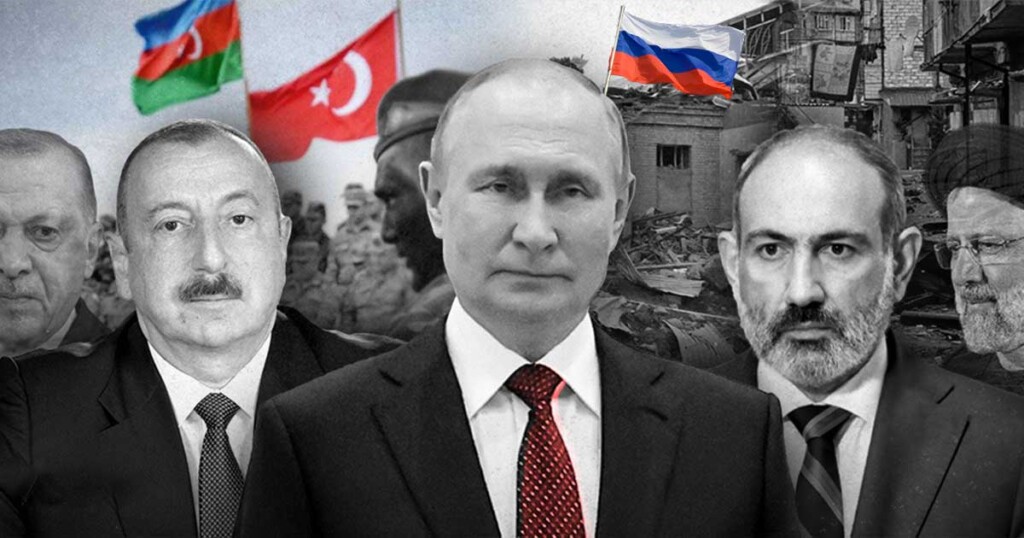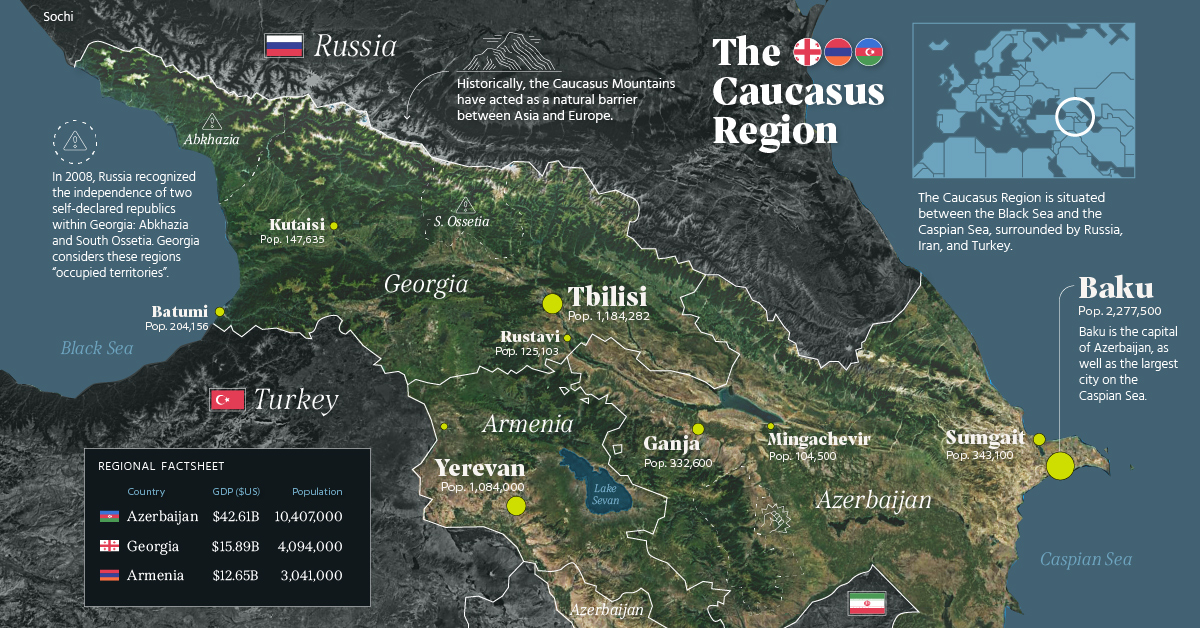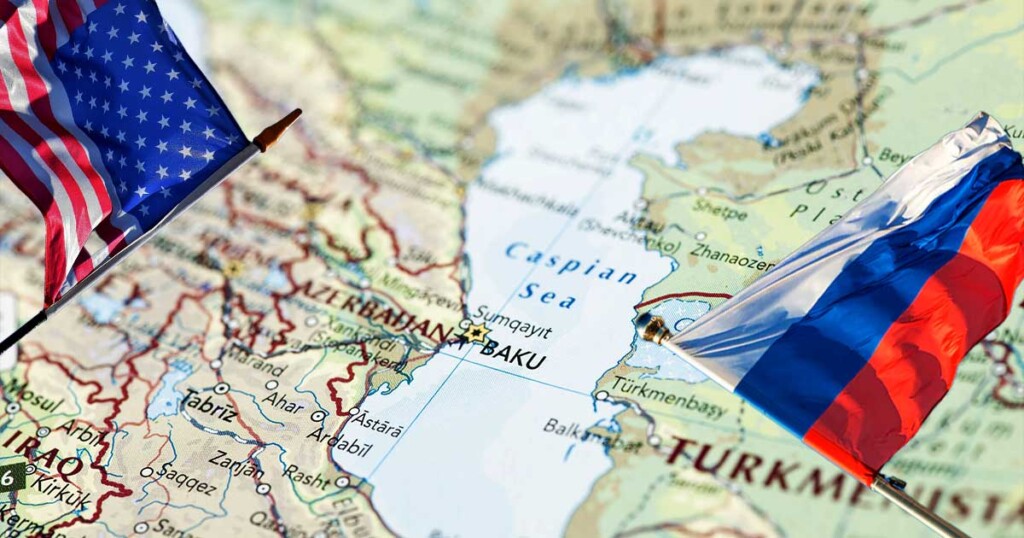The Russo-American conflict in the Caucasus is significant. In recent years, the two countries have simultaneously competed and cooperated in several regional crises. Their policies in this region draw considerable attention. These states have different approaches to politics, military affairs, and economics in the South Caucasus and do not follow a unified line. To understand this issue, it is necessary to objectively explain the differing approaches of Russia and the United States to the Caucasus region.
THE SOUTH AND NORTH CAUCASUS – A SYSTEM OF CONNECTED VESSELS
The North Caucasus (Adygea, Ingushetia, Dagestan, Kabardino-Balkaria, Karachay-Cherkessia, North Ossetia, and Chechnya) covers a larger area than the three independent states of the South Caucasus combined. Ethnic and political conflicts in the North Caucasus—such as the Ingush conflict and the situation in Abkhazia—are directly linked to crises in the South Caucasus.
For example, tensions between Georgia and South Ossetia have a serious impact on the Ingush conflict in North Ossetia, Russia. This demonstrates that the Kremlin cannot guarantee stability and security in the North Caucasus without a stable situation in Georgia, Armenia, and Azerbaijan.
At the same time, the United States maintains an egocentric approach toward the Caucasus. In its effort to preserve global leadership, Washington does not ignore regional issues. The absence of U.S. engagement in the Caucasus could make it more difficult to counter Russian strategies in the region, especially in the fields of security and defense.
The Caucasus occupies a vital strategic position between Central and Western Asia. Russia views its security as dependent on controlling external threats and therefore perceives U.S. activities in the region as a destabilizing factor.
For its part, America has three main goals in the Caucasus: studying the region, cooperating with newly independent states, and securing energy projects.
Today, there is much discussion about the “end of Russian hegemony” in the South Caucasus. For instance, the influential German researcher Stefan Meister and the well-known American expert on Eurasia Jeffrey Mankoff have both published works on this topic almost simultaneously. Yet, if one approaches the issue systematically, it is first necessary to understand what the term hegemony actually means and to clearly define what we imply by it.
The fear of Russia stems from the possibility of its territorial expansion. American theorists and policymakers tend to interpret all ethnic conflicts in the former USSR within this context. The book “A Little War That Shook the World” by the prominent American foreign policy theorist and practitioner Ronald Asmus begins with the thesis that the roots of the Georgian-Abkhaz and Georgian-Ossetian conflicts do not lie in ethnopolitical tensions but in Moscow’s geopolitical ambitions. If Russia is the one that benefits, then—according to this logic—it must be a case of open or covert territorial expansion.
DO NOT UNDERESTIMATE WASHINGTON
For now, the South Caucasus does not occupy a priority position on Donald Trump’s agenda. However, the region has attracted the interest of those close to him—certain members of the Republican Party and lobbyists from the Armenian and Azerbaijani diasporas active in Washington. Trump prefers direct deals in which U.S. interests are clearly and pragmatically defined. In that sense, his involvement in the peace process between Armenia and Azerbaijan would only be possible under a scenario favorable to the United States.
Russia views such a prospect with some concern. Every American initiative in the South Caucasus is perceived as an attempt to push Russia out of its traditional spheres of influence.
At one time, the United States tolerated the role of the Russian Federation in resolving the Karabakh issue, since Russia neither recognized the NKR (Nagorno-Karabakh Republic) nor even hypothetically planned a referendum on its accession to Russia. Until at least 2022, the Americans allowed Moscow to take the lead, believing that in the field of peace diplomacy there were few points to gain but many potential problems to create.
With the beginning of the Special Military Operation (SMO), the U.S. sharply increased its activity in the Caucasus, attempting to push Russia out of this strategically vital region.
On July 22, the well-known Spanish newspaper Periodista Digital published an article claiming the existence of a secret plan for an American company to lease the “Zangezur Corridor.” The project has already been nicknamed the “Trump Bridge” in the media. The Armenian government officially denied the allegations from the Spanish publication. However, shortly before the article was published, Nikol Pashinyan himself mentioned the possibility of an “outsourcing” solution to the issue of the Zangezur Corridor.
Moreover, by mid-July, the terms “South Caucasus” and “United States” began to appear together far too frequently. All events in which these two concepts were mentioned represent significant developments for both regional and international security.
The “Trump Route”—as a framework for unblocking transport communications between Azerbaijan and Armenia—and the Agile Spirit 2025 military exercises in Georgia indicate that Washington should by no means be underestimated when considering the future prospects of the Caucasus region.

SYMPATHY TOWARD ALIYEV
Much has been written—often eagerly—about the so-called “end of history” of American presence in Transcaucasia. This was the case in August 2008, when Moscow conducted the “Operation to Force Georgia to Peace” and subsequently recognized the independence of two former autonomous regions of the Georgian SSR.
Similar assessments were voiced in November 2020, when the “second Karabakh war campaign” concluded, and again in September 2023, following the end of Azerbaijan’s briefest military operation against the unrecognized Nagorno-Karabakh Republic (NKR).
However, Washington always managed to find some form of response—be it the Charter on Strategic Partnership with Georgia in 2009, the “Washington negotiation format” on Karabakh, or the de facto transformation of the OSCE Minsk Group from a trio into a duo with France in 2022–2023. In 2024, the United States unilaterally “froze” its Charter with Tbilisi. Yet by January 2025, immediately after the New Year break, a similar document appeared—this time signed by representatives of Washington and Yerevan.
At first glance, after the “third Karabakh war,” accompanied by the process of “de-Armenization” of the region, it might have seemed that relations between the United States and Azerbaijan had entered a serious crisis. Yet four months later, in 2024, President Ilham Aliyev accepted the credentials of newly appointed U.S. Ambassador Mark Libby.
The situation evolved even faster following Donald Trump’s return to the White House. Recently, the 47th (and previously 45th) President of the United States shared an excerpt from Ilham Aliyev’s speech at the 3rd Global Media Forum in Shusha on his social platform, and the Azerbaijani leader did not miss the opportunity to thank his American counterpart for the gesture.
Incidentally, the portion of the speech that Trump shared dealt with the partnership between Baku and Washington.
FROM VARNA TO TBILISI – COLUMNS OF ARMORED VEHICLES WITH AMERICAN FLAGS
In June 2024, the U.S. Department of Defense unilaterally postponed the Noble Partner military exercises in Georgia. The reason given was Washington’s accusations that the Georgian authorities were allegedly spreading false claims about the United States. The Americans refused to acknowledge allegations that they had pressured Georgia to open a “second front” against Russia in the Caucasus.
A little over a year later—and now with all the ceremony befitting the moment—U.S. representatives announced the Agile Spirit military exercises. The first phase of the maneuvers was held in Turkey.
“The Agile Spirit has landed,” declared the U.S. Army Europe and Africa Command on July 21, commenting on a joint airborne operation with Turkey. Then it was Georgia’s turn: from Varna, Bulgaria, columns of armored vehicles bearing U.S. flags traveled across the sea to the port of Poti and then by land to Tbilisi.
A clear signal: no one intends to withdraw. The Caucasus continues to attract American attention, despite the significant distance of the U.S. from this area of its geopolitical interest.
In any case, the plans for long-term control over the “Zangezur Corridor” can be seen as part of Washington’s broader strategy to secure a permanent presence in Transcaucasia, along Iran’s northwestern border—thus contributing to continued confrontation with Tehran.
A NEW GUANTÁNAMO ON THE TERRITORY OF ARMENIA
According to unconfirmed information from the Spanish outlet Periodista Digital, the alleged “Trump Bridge” project in the Syunik Mountains involves the deployment of a “significant American contingent” on Armenian territory, in the form of a private military company (PMC) of approximately one thousand personnel.
The Turkish newspaper Aydınlık Gazetesi also reported:
“…the deployment (in Syunik) of forces belonging to a private military company essentially means that the region will fall out of Yerevan’s control. These forces will mainly consist of retired mercenaries from the U.S. and Western armies.”
According to the same source, 40% of the corridor’s revenue would go to the American operating company, while Armenia would have to settle for only a 30% share.
As Nikol Pashinyan, who visited Turkey in June, stated:
“The corridor cannot come fully under Azerbaijan’s control; the issue must be resolved based on the principles of mutual respect for territorial integrity and equality.”
The inclusion of the United States in the project under the guise of “neutrality,” by all appearances, reduced Pashinyan’s objections to a minimum. It is not difficult to see that, to some extent, the entire envisioned structure—if it were to materialize—would resemble the indefinite and enduring presence of the American Guantánamo base in southeastern Cuba.

UNDER THE WATCHFUL EYE OF TEHRAN
It is therefore not surprising that Iran has voiced rather sharp assessments of the situation. According to a recent statement by Ali Akbar Velayati, adviser to the Supreme Leader of the Islamic Republic of Iran, “The enemies of Iran—particularly global Zionism and the United States—are seeking projects such as the Zangezur Corridor as a cover for larger geopolitical schemes. The main goal is to weaken the Axis of Resistance, sever Iran’s ties with the Caucasus, and create a land blockade of Iran and Russia in the southern part of the region.”
Moreover, Velayati added: “This project is not merely part of an American plan to replace the Ukrainian front with the Caucasus as a new pressure belt on Russia and Iran—it is also being carried out with the support of NATO and several Pan-Turkic movements.”
According to an official representative of Iran’s Ministry of Foreign Affairs, “All transport corridors connecting mainland Azerbaijan with Nakhchivan must comply with the principles of national sovereignty and territorial integrity of the states in the region.”
Accordingly, Tehran is closely monitoring the process, as it directly affects the country’s national interests.
Baku is well aware of Iran’s firm stance, “and therefore seeks to avoid a direct confrontation with Tehran. This is precisely why it is attempting to involve various international actors—including Israel, the United Kingdom, the United States, and NATO—to raise the stakes and contain potential political and military interference by Iran in this issue,” explained Hossein Salar Seyfoddin, an Iranian expert on the South Caucasus.
THE PROJECT IS NOT OF RECENT ORIGIN
It is worth recalling that in the second half of the 1980s, a group of economists led by academician T. S. Khachaturov proposed the implementation of a similar project—one that had appeared in various forms as early as the 1950s and early 1970s. The plan envisioned the construction of a railway line from Lachin (the administrative center situated between Armenia and what was then the Nagorno-Karabakh Autonomous Region of Azerbaijan) to Nakhchivan, with branch lines to Stepanakert, Agdam, Yevlakh, and Barda. The goal was to strengthen economic ties in the southern Transcaucasus, connect with the Caspian Sea, and exploit the region’s abundant mineral resources.
This line would have represented the shortest route between Nakhchivan and central Azerbaijan. The project was preliminarily approved by the State Planning Committee (Gosplan) and the Ministry of Transport of the USSR.
However, since the route passed through Nagorno-Karabakh, officials in Baku assessed that the railway might increase the region’s “gravitational pull” toward Armenia. Conversely, in Yerevan, there were fears of the opposite—that the line would result in excessive Azerbaijani presence within Armenia.
As a result, a compromise was reached between Yerevan and Baku: they limited themselves to the so-called “Trans-Siberian Railway of the Transcaucasus” and the existing highway from Baku, which passed through Nagorno-Karabakh and then via Zangezur to Nakhchivan.
A new escalation along the southern Armenian-Azerbaijani border could permanently alter the region’s map in terms of resources, economy, and even politics. And it is unlikely that such changes would favor Armenia—one of the few proven allies, or at least supporters, of Russia.
Baku rejected that earlier Soviet project, fearing a direct railway link between Nagorno-Karabakh and Armenia, and instead insisted on constructing a highway through the Meghri district toward the Nakhchivan ASSR.
The railway section in southern Armenia, which had operated since the mid-1940s as part of the border line with Iran—Yerevan – Nakhchivan – Julfa – Meghri – Goradiz – Imishli – Alyat – Baku—has not been in use since 1990 (nor has the line itself).
During the Soviet era, this section was under the jurisdiction of the Azerbaijani Railways, a fact that Baku continues to invoke in its official statements to this day.
STRATEGY ON THE CAUCASUS FRONT
What, then, are the United States seeking in the distant Caucasus? The U.S. shares no borders with the region, and the influence of the Caucasian diasporas in America is not particularly strong—especially when compared to the Jewish or Irish factors.
Nevertheless, the Armenian diaspora largely remains a “diaspora of a single issue”—the issue of genocide recognition, as its own activists frequently acknowledge.
A common point among American Eurasian experts is the assertion that the South Caucasus is important to Washington, but not of decisive, critical importance.
The American elite, unlike the Russian, views Transcaucasia through a different lens. In this perspective, the main objects of interest are not Azerbaijan, Armenia, and Georgia, but primarily Russia, Turkey, and Iran.
In recent years, however, U.S. foreign policy strategy in the Caucasus direction has come to include China as well, given Beijing’s growing economic and political ties with Tbilisi, Baku, and, to a lesser extent, Yerevan.
The relationship with Turkey is different—Ankara is a strategic ally, not an adversary, yet a stubborn and willful one, prone to sudden geopolitical “revisions,” perhaps even more so than Russia.
As a result, Washington strives to maintain a balance between “disciplining” Turkey (even through instrumentalizing the “Armenian question”) and encouraging its regional ambitions, which can be leveraged as a counterweight to Russia and Iran.
The Agile Spirit military exercise is, in fact, a striking example of this approach.
RECONCILIATION BETWEEN ISRAEL AND TURKEY?
Iran, like Russia, remains an adversary in Washington’s eyes. If we assume that the “Trump Route” is not merely a fabrication—and the number of comments and reactions to this project suggests that it is not—then its edge would be directed not only against Moscow but also against Tehran.
Whatever the developments may be, the United States is deeply interested in strengthening the Azerbaijan–Israel axis, as well as in further developing relations with Baku, however complex they may be.
There is another interest at play: reconciling two of America’s “wayward” allies—Israel and Turkey—and, if necessary, doing so through the mediation of Azerbaijan.
It is no coincidence that Ilham Aliyev’s aide, Hikmet Hajiyev (the president’s chief spokesperson for foreign policy), stated in a recent interview with Berliner Zeitung, after proposing Baku as a venue for peace talks between Russia and Ukraine:
“Talks between Turkey and Israel were held here. Syria and Israel also conducted negotiations in Baku.”
China’s Belt and Road Initiative represents, for the United States, a competing project across Eurasia as a whole—not just in Transcaucasia. Yet, “here and now,” Washington’s greatest concern lies in China’s growing economic influence, particularly in Georgia, where the port of Anaklia is under development.
If one adds to this the broader regional political economy—the energy factor, the search for alternative energy supply routes for European Union allies, the consolidation of positions in the Black Sea and Caspian basins, and the linking of the Caucasus with the Middle East and Central Asia—it becomes clear that Washington’s “concern for Zangezur” is presented as a means of reducing Russian and Chinese influence in Eurasia.

HOW SYUNIK BECAME THE WESTERN ZANGEZUR
In parallel, the United States has been strengthening its military-technical ties with Georgia without granting it formal NATO membership, applying a model of special partnership similar to Washington’s relations with South Korea, Japan, Israel, or even Francoist Spain in the past. At the same time, the U.S. has consolidated its role as the chief moderator in resolving the Armenian-Azerbaijani conflict, while seeking to contain Russia, Iran, and China, and to optimize relations with its difficult but important ally—Turkey. These are the key points of the American agenda in the South Caucasus. Whether one finds this policy acceptable or objectionable, it must first and foremost be understood.
Azerbaijan is divided into two parts by the Syunik province of the Republic of Armenia. Following the victorious recovery of the Nagorno-Karabakh territories, the issue of the so-called Zangezur Corridor has reemerged in Baku. It is evident that Baku’s strategic ambitions go far beyond the mere opening of a transport route—and that “something more” is not in the interest of either Armenia or neighboring Iran.
For Azerbaijan, gaining control over Zangezur represents a kind of strategic maximum plan. As early as 2021, Ilham Aliyev introduced changes to the country’s administrative-territorial structure, forming the Eastern Zangezur Economic Region, which includes Jabrayil, Lachin, Kalbajar, Gubadli, and Zangilan. Meanwhile, the neighboring Armenian province of Syunik has already been referred to in official Azerbaijani rhetoric as Western Zangezur—“historical lands.”
Of course, in such a context, each side can increasingly invoke historical arguments, given the region’s turbulent past. Yet, for now, international law remains on Yerevan’s side, even though, in practice, everything is ultimately determined by the actual balance of power.
RUSH FOR RESOURCES
In the meantime, emotions and sharp statements are boiling around this small but extremely important node of political geography.
The CSTO is preparing a mission to assess the situation (considering measures to strengthen the border in the area of the city of Syunik and along the route used for transporting raw materials). Tehran is maintaining a strike group on the banks of the Aras River. Baku is exploring possibilities for military-technical cooperation with Israel, while at the same time, both Iran and Azerbaijan have begun constructing a new bridge linking Karabakh and Iran, along with plans to build new power plants and export electricity.
The attempt at occupation—so far rather successful—of just 30 square kilometers in Syunik is likely connected to the fact that two of Armenia’s major metallurgical centers, Kapan and Kajaran, are located in the immediate vicinity of this expropriated zone. These are the country’s two principal hubs of non-ferrous metallurgy. It is worth recalling that, in the mid-1980s, their combined output accounted for about 15% of the total production of non-ferrous metals in the USSR.
In addition to these plants, there are significant deposits of high-quality ores of cobalt, vanadium, molybdenum, bismuth, copper, and rare earth elements. The total volume of these reserves in southern Armenia reached 20% of the USSR’s overall reserves of such resources between the 1930s and the 1980s. However, the current level of actual development in southern Armenia barely reaches 35%.
Moreover, most of these deposits are concentrated precisely near the southern sector of the Armenian-Azerbaijani border. And most importantly—near the new point of contention—exactly around those same 30 square kilometers in Syunik that are now under Azerbaijani control.
The United States is in no hurry to get involved there by accident.





